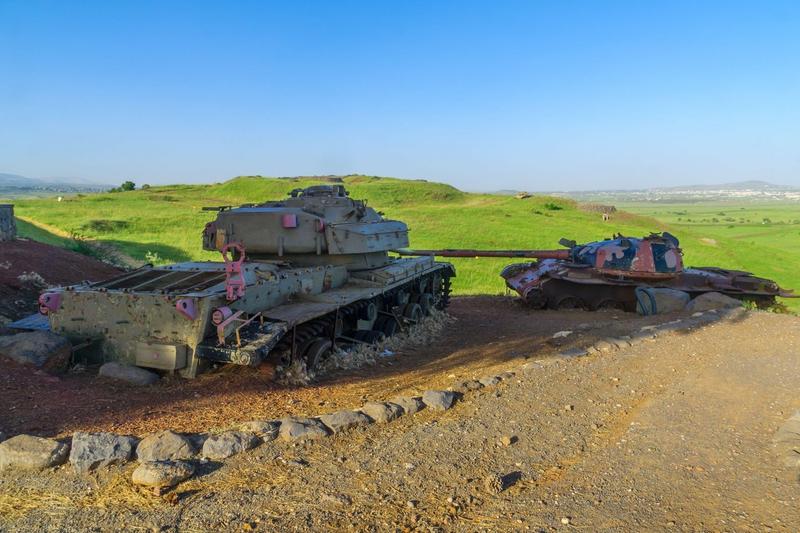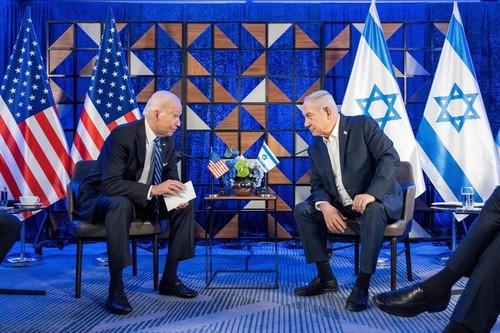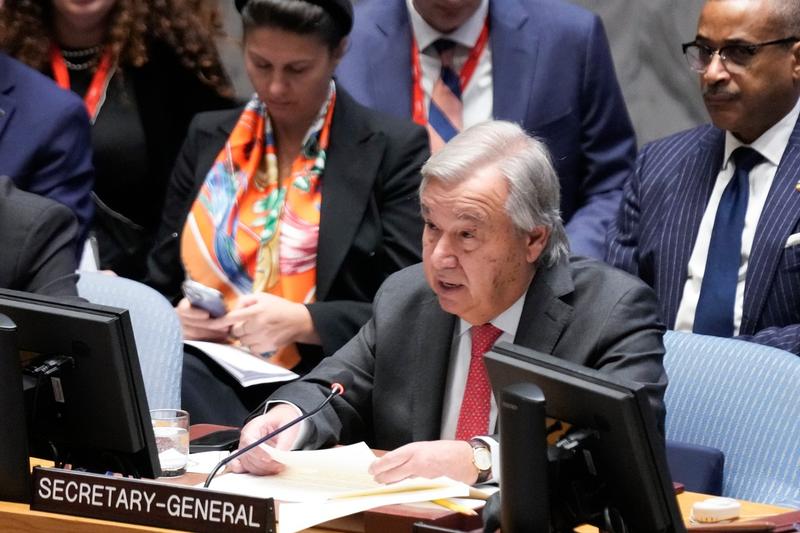
The war in Gaza has brought renewed attention to the two-state solution to the Israeli-Palestinian conflict, which is still seen by many countries as the path to peace, even though the negotiation process has been stalled for years.
More than three months after the start of the bloodiest Israeli-Palestinian war to date, Washington has said it is impossible to solve Israel’s security problems and the task of rebuilding Gaza without a Palestinian state.
But Israeli Prime Minister Benjamin Netanyahu has voiced his opposition to Palestinian sovereignty, saying he would not compromise on full Israeli security control west of the Jordan and that it would be against a Palestinian state.
Obstacles for a long time hindered the resolution of the two neighboring states. They include:
- Jewish settlements in the occupied lands, which the Palestinians want to create a state,
- uncompromising positions on key issues, including Jerusalem,
- violence and deep mistrust.
Origins of the “two states” solution.
The conflict in Palestine, which is under British rule, became the catalyst for the decision to create two states. Jews, fleeing from European persecution, migrated and claimed biblical ties to the country. In 1947, the UN proposed a partition plan for Palestine, which was accepted by the Jews and rejected by the Arab League. The State of Israel was proclaimed in 1948, and subsequent wars with the Arab world ended with Israel gaining control of 77% of the territory.
Consequences of the war and displacement of Palestinians
As a result of the conflict, 700,000 Palestinians became refugees in Jordan, Lebanon, Syria, Gaza, the West Bank and East Jerusalem. In 1967, Israel conquered the West Bank and Gaza, expanding its control. Palestinians remained stateless, living under occupation or as refugees. Some with Israeli citizenship.
The “two-state” solution and the failure of the peace process
The peace process initiated by the Oslo Accords (1993) was based on the principle of the creation of two states. However, this has been overshadowed by rejection, violence and major obstacles such as the status of Jerusalem and the borders of a Palestinian state. Subsequent attempts, including at Camp David in 2000, failed due to disagreements over these issues and escalation of the conflict.

Oz 77 Memorial (Valley of Tears) Photo: RnDmS / Alamy / Alamy / Profimedia
What can Palestine be like?
Proponents of the decision to create two states envisioned the creation of Palestine in the Gaza Strip and the West Bank of the Jordan River, connected by a corridor through Israel.
Two decades ago, the details of how it might work were laid out in a draft by former Israeli and Palestinian negotiators.
The principles, known as the Geneva Accords, include recognizing the Jewish areas of Jerusalem as the capital of Israel and recognizing its Arab areas as the capital of Palestine, as well as a demilitarized Palestinian state.
The Palestinians hoped that this would be a step towards an independent state with its capital in East Jerusalem.
Violent reactions and the murder of Rabin
The trial was accompanied by pushback and violence from both sides.
Hamas, which opposed the trial, carried out suicide attacks that killed dozens.
Rabin was assassinated in 1995 by an Israeli ultranationalist who opposed his peace policies.
In 2000, US President Bill Clinton brought Arafat and Israeli Prime Minister Ehud Barak to Camp David to broker a deal, but the effort failed.
The fate of Jerusalem, which Israel considered its “eternal and indivisible” capital, was a stumbling block.
Israel was to annex large settlements and hand over other lands in exchange.
A multinational force working alongside Palestinian security forces will control the Palestinian borders with Jordan and Egypt, as well as air and sea ports.
US President Joe Biden and Egyptian President Abdel Fattah al-Sisi have mentioned the idea of a demilitarized Palestinian state – an idea that Abbas has never publicly rejected or embraced, but which Hamas rejects.

Joe Biden and Benjamin Netanyahu Photo: White House Photo / Alamy / Profimedia Images
How big are the obstacles?
Obstacles have grown over time, and a two-state solution seems less and less likely.
While Israel withdrew its settlers and soldiers from Gaza in 2005, Jewish settlements have expanded throughout the rest of the territory where the Palestinians want to establish a state. Palestinians say this undermines the prospects for a viable state.
The Israeli organization Peace Now said in September that their numbers had risen from 250,000 in the West Bank and East Jerusalem in 1993 to 695,000 three decades later.
During the Second Intifada, Israel also built what it called a barrier to stop Palestinian attacks. Palestinians call it a land grab.
The Palestinian Authority (PA), led by President Mahmoud Abbas, governs the West Bank territories surrounded by the Israeli control zone, which covers 60 percent of the territory, including the Jordanian border and settlements – arrangements outlined in the Oslo Accords.
- On the same topic: Israeli-American dispute over Palestinian state deepens / Borrell: Israel created and financed Hamas to prevent the creation of a Palestinian state
Political events further complicated the situation
Netanyahu’s government is the most right-wing in Israel’s history and includes religious nationalists supported by settlers. Finance Minister Bezalel Smotrich said last year that the Palestinian people do not exist.
On the other hand, Hamas gained political and military power by winning the 2006 elections, and a year later ousted forces loyal to Abbas from Gaza, dividing the Palestinians politically.
Hamas’s 1988 founding charter calls for the destruction of Israel and refuses to recognize Israel.
In 2017, a document issued by Hamas said it accepts a transitional Palestinian state within the borders of the 1967 war, although it remains opposed to recognizing Israel’s right to exist or denying any rights to Palestinians.
Israel opposes the proposal as a trap.
Is there a way forward?
Israel wants to destroy Hamas and rejects any pact that would keep the organization in power. Prime Minister Netanyahu is pushing for demilitarization and full Israeli security control in Gaza, excluding direct Israeli rule or the resumption of settlements in the area.
Hamas rejects any deal that does not include it and is open to talks with Fatah on the formation of a unity government.
The US, considering Hamas a terrorist group, wants to establish a government in Gaza and the West Bank under the auspices of the Palestinian Authority.
Abbas believes that Netanyahu’s latest statements show a lack of interest in peace and stability. A Hamas official says the Palestinians will not accept anything short of a sovereign state with its capital in Jerusalem.

Antonio Guterres, UN Secretary General Photo: Seth Wenig / AP / Profimedia
Is there an alternative?
As the two-state solution failed, talks began of a one-state solution. Some Palestinians, convinced that Israel will never cede sovereignty to them, favor a transition to fighting for rights within a single state that includes Israel and the territory it occupied in 1967.
Critics say it is unrealistic, noting that the main Palestinian factions do not support it and that Israel would never accept an idea that could jeopardize its existence as a Jewish state.
UN Secretary-General Antonio Guterres said in a speech on January 23 that the two-state solution remains the only way to satisfy the aspirations of Israelis and Palestinians.
He criticized “the clear and repeated rejection of the two-state decision at the highest level of the Israeli government.”
“This rejection and denial of the Palestinian people’s right to statehood will lead to an endless prolongation of the conflict, which has become a serious threat to global peace and security,” he said.
“The population of Gaza as a whole is experiencing destruction on a scale and speed unprecedented in recent history. Nothing can justify the collective punishment of the Palestinian people,” said António Guterres.
On the same topic:
- “It can’t go on like this”: Josep Borrell criticized Israel for seeking to destroy Hamas
Source: Hot News
Ashley Bailey is a talented author and journalist known for her writing on trending topics. Currently working at 247 news reel, she brings readers fresh perspectives on current issues. With her well-researched and thought-provoking articles, she captures the zeitgeist and stays ahead of the latest trends. Ashley’s writing is a must-read for anyone interested in staying up-to-date with the latest developments.